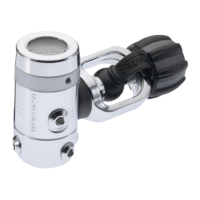GB
16
Regulator Owner’s Manual
............................................................................................
Auxiliary Emergency Breathing Systems
For safety reasons when using Self Contained Underwater Breathing
Apparatus (SCUBA), it should always be recommended to use an
appropriate alternative breathing air (gas) source/secondary life support
system. This recommendation can vary depending on location and training
agencies you have received your training from and you must follow how
you have been trained. However, it is common practice within recreational
diving and during some commercial diving to use an Auxiliary Emergency
Breathing System also known as an Octopus or Alternative Air Source
second stage, to fulfil or support this requirement.
An Octopus is a secondary demand valve, designed to work in conjunction
with the primary demand valve and they are both connected to the first
stage pressure reducer. The Octopus provides a backup demand valve in
cases of primary demand valve failure and may also act as an Alternative
Air Source (AAS) for the diving Buddy. An AAS does not require the Donor
diver to remove their own primary demand valve when supplying gas
to a Buddy diver who has experienced regulator failure or an out of gas
situation.
By its very nature (other than during training exercises) this type of
apparatus is only expected to be used during emergency situations and is
therefore likely to experience very high ventilatory demand, as it is required
to support two divers breathing at the same time.
SCUBA single demand regulators capable of meeting the breathing perfor-
mance requirements of BS EN 250:2000 cannot be relied upon to meet the
same performance requirements when used as part of an Octopus system.
This is due to requiring twice the performance from the first stage pressure
reducer in an already strenuous environment.
Reduced breathing performance of second stage demand valve systems
may be experienced when using low performance first stage pressure
reducers with poor performing and incompatible second stage demand
valves. This may go some way to explaining the number of divers who
inexplicably break contact with their buddies during alternative air supply
(AAS) ascents using some SCUBA Octopus systems.

